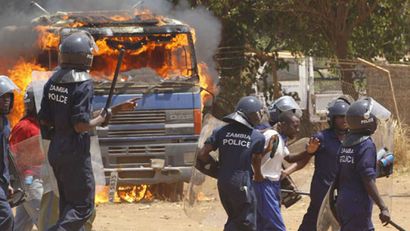2018 Kanyama riots
| 2018 Kanyama riots | |||
|---|---|---|---|
 | |||
| Date | 12 January 2018 | ||
| Location | Kanyama, Lusaka | ||
| Caused by | Regulations imposed to control the spread of a cholera epidemic in Lusaka. | ||
| Goals | Traders chanting we want change. | ||
| Methods | Rioting | ||
| Status | Ended | ||
| |||
| Injuries | 62 | ||
| Arrested | 55 arrested by police[1] | ||
| Charged | 33 | ||
The 2018 Kanyama riots took place on 12 January 2018 after regulations imposed on trading in a bid to curb the spread of the cholera epidemic in Lusaka. Kanyama residents ran amok destroying property worth millions of Kwacha in protest against the removal of marketeers at Total filling station in the area. The irate residents also burnt a tipper truck and looted several shops.[2]
Background
In late 2017, Lusaka experienced a cholera epidemic that claimed dozens of lives. To limit public spread, officials implemented restrictions including a curfew in Kanyama and banned street vending along busy areas such as Los Angeles Road.[3][4]
Kanyama residents whose livelihood were disturbed by the decision to ban street vending fought running battles with riot police. The residents mobilized themselves and blocked roads, burnt tyres and threw stones at police officers who attempted to quell the unrest. The residents were protesting against their removal from the streets and the curfew imposed on them by government in a bid to curb the spread of the cholera epidemic.[5]
Events
When enforcement began on 11 January, traders resisted, leading to: - Roadblocks and tyre-burning - Stone-throwing at police and looting of shops[4] - Arson, including setting alight a garbage truck used for collection[6] Police responded with tear gas, warning shots, and arrests; approximately **55 rioters** were detained.[1]
Response
The Zambia Army and riot police were deployed. Local authorities directed residents to stay indoors.[4][6]
Home Affairs Minister Steven Kampyongo stated that enforcement was necessary to protect public health, while opposition figures criticized the ban, calling it excessive. NDC consultant Chishimba Kambwili defended the traders and pushed for improved sanitation and piped water delivery.[6]
Casualties and aftermath
No confirmed deaths were reported. Some police and civilians sustained injuries, though exact numbers were not released. Businesses suffered property damage and income loss. A long-term outcome was accelerated investment in sanitation and water infrastructure; a long-planned piped-water project in Kanyama was expedited.[6]
Significance
The riots highlighted tensions between public health measures and livelihoods in low-income urban communities. They sparked dialogue about balancing disease containment with socio-economic rights, influencing subsequent policy on sanitation improvement and urban planning.[3][4]
Also see
References
- ↑ 1.0 1.1 "Zambia arrests 55 in riots over cholera control rules", Reuters, 12 Jan 2018.
- ↑ ARMY QUELLS KANYAMA RIOT, ZNBC, 12 January 2018
- ↑ 3.0 3.1 "Zambia Cholera Deaths Rise as Police Arrest 55 After Riots", *Bloomberg*, 12 Jan 2018.
- ↑ 4.0 4.1 4.2 4.3 "Zambian army enters populous slum to control riots over cholera outbreak", Africanews, 13 Jan 2018.
- ↑ Riots break out in Kanyama over Street Vending as HH calls for calm, Lusaka Times, 12 January 2018
- ↑ 6.0 6.1 6.2 6.3 "Zambia Army moves in and quells Kanyama riots", *Lusaka Times*, 12 Jan 2018.